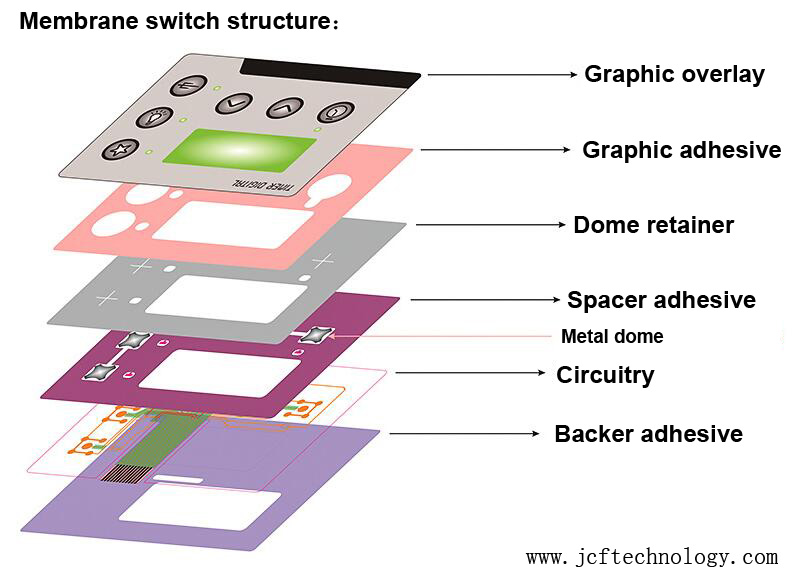The Role of Membrane Switches in Enhancing Device Functionality
The Role of Membrane Switches in Enhancing Device Functionality
Blog Article
Recognizing Membrane Layer Switches: The Key to Trusted and resilient Controls

What Are Membrane Layer Buttons?
Membrane buttons are an innovative service in the realm of interface modern technology, combining functionality and design flawlessly. These tools serve as an interface between users and electronic systems, integrating a number of elements right into a small style. Commonly built from adaptable, slim layers of products, membrane layer buttons are made to react to touch, making it possible for users to interact with machinery and electronic tools efficiently.
The main aspects of a membrane switch include a published circuit layer, visuals overlay, and a spacer layer that protects against unintended activation. The visuals overlay can be tailored to show brand identity or user choices, boosting aesthetics while ensuring use. Membrane layer switches are generally utilized in different applications, including medical devices, customer electronics, and commercial tools, owing to their durability and resistance to ecological factors such as moisture and dirt.
Among the essential benefits of membrane switches is their capacity to stand up to wear and tear, making them ideal for high-traffic settings. Furthermore, they are light-weight and need minimal area, allowing for cutting-edge styles in product growth. Generally, membrane changes represent a effective and useful selection for contemporary digital interfaces, weding technology with user-centric design principles.
Exactly How Membrane Layer Changes Job
The procedure of membrane layer switches joints on a simple yet efficient system that converts customer input into electronic signals. When a customer presses the switch, the top layer warps, enabling a conductive component in the circuit layer to make call with a corresponding conductive pad on the bottom of the visuals overlay.
The design of membrane switches can vary, but they commonly include domes or responsive components to provide comments to the customer, boosting the total experience - membrane switch. The materials used in membrane buttons, such as polyester or polycarbonate, add to their resilience and resistance to environmental aspects, consisting of wetness and dirt. Furthermore, the printed circuits are generally encapsulated, which safeguards them from deterioration in time.
Advantages of Membrane Switches

Additionally, membrane layer switches are known for their sturdiness. Created from durable products, they are immune to dirt, moisture, and physical wear, which substantially expands their life-span contrasted to typical mechanical buttons. This longevity makes them particularly ideal for high-traffic settings and applications calling for long life.
An additional considerable advantage is the simplicity of cleansing and maintenance. The smooth surface of membrane switches decreases dirt buildup and is commonly resistant to spills, making them suitable for setups that need frequent sanitization.
Moreover, membrane layer switches provide a streamlined account, causing a thinner style that can be integrated right into numerous tools without including bulk. This attribute not just improves the aesthetic allure but likewise adds to a more ergonomic product layout.
Applications of Membrane Layer Switches
Easy to use and versatile, membrane layer buttons find applications throughout a large range of sectors, including clinical gadgets, consumer electronic devices, and industrial tools. In the medical area, these switches are integral to gadgets such as diagnostic tools, client monitoring systems, and mixture pumps, where reliability see post and convenience of cleaning are critical. Their capability to withstand rough atmospheres and keep functionality makes them perfect for such applications.

In customer electronic devices, membrane switches are made use of in products like microwaves, washing machines, and push-button controls - membrane switch. Their streamlined design permits instinctive user interfaces, improving the total user experience while supplying durability and resistance to tear and put on
Commercial equipment also takes advantage of membrane layer buttons, specifically in control panels for machinery and automation systems. These switches provide security versus dirt and dampness, guaranteeing constant original site performance in difficult settings. Moreover, their customizable features enable makers to customize them to certain functional requirements, boosting performance and capability.
Choosing the Right Membrane Layer Change
When choosing a membrane layer button, it is necessary to take into consideration different aspects that influence efficiency and viability for particular applications. The primary considerations consist of ecological conditions, tactile feedback, durability, and layout requirements.
First, examine the operating atmosphere; switches revealed to dampness, chemicals, or severe temperature levels require specific products to make sure longevity and capability. Next off, assess the need for responsive comments. Depending on customer interaction, some applications may take advantage of a tactile action to confirm activation, while others might like a non-tactile design for aesthetic reasons.
Resilience is an additional essential factor; membrane layer switches should be designed to hold up against regular usage, effects, and abrasion. Guarantee the picked switch can sustain the anticipated lifecycle, particularly in high-usage circumstances.

Conclusion
In final thought, membrane layer switches serve as necessary parts in the design of long lasting and helpful site reliable control systems throughout numerous industries. The adaptability of membrane layer switches over allows for tailored services that fulfill certain operational demands, enhancing their value in modern technology.
Membrane layer switches represent an essential aspect of modern interface style, blending performance with durability in numerous applications.Membrane layer buttons are a sophisticated solution in the realm of user interface technology, combining performance and layout seamlessly. Generally constructed from flexible, thin layers of materials, membrane switches are developed to respond to touch, allowing users to interact with machinery and digital tools efficiently.
The style of membrane layer switches can vary, but they often integrate domes or responsive components to provide responses to the customer, boosting the total experience.In conclusion, membrane layer changes serve as vital elements in the design of dependable and resilient control systems throughout numerous markets.
Report this page